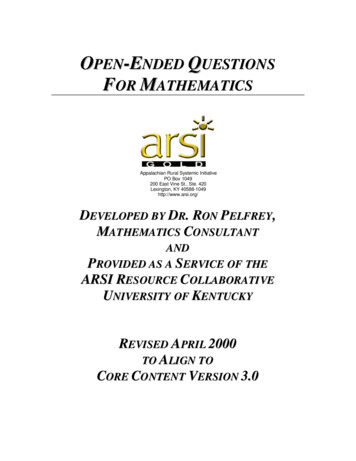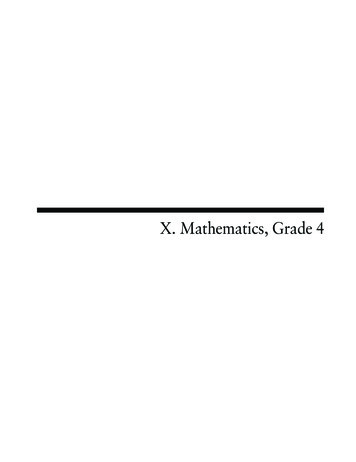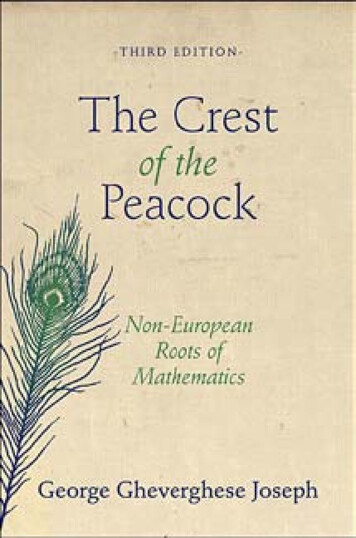
Transcription
A Brief History of Mathematics
A Brief History of MathematicsWhat is mathematics?What do mathematicians do?
A Brief History of MathematicsWhat is mathematics?What do mathematicians do?http://www.sfu.ca/ rpyke/presentations.html
A Brief History of Mathematics Egypt; 3000B.C.–––––Positional number system, base 10Addition, multiplication, division. Fractions.Complicated formalism; limited algebra.Only perfect squares (no irrational numbers).Area of circle; (8D/9)² Æ 3.1605. Volume of pyramid.
A Brief History of Mathematics Babylon; 1700‐300B.C.– Positional number system (base 60; sexagesimal)– Addition, multiplication, division. Fractions.– Solved systems of equations with many unknowns– No negative numbers. No geometry.– Squares, cubes, square roots, cube roots– Solve quadratic equations (but no quadratic formula)– Uses: Building, planning, selling, astronomy (later)
A Brief History of Mathematics Greece; 600B.C. – 600A.D. Papyrus created!– Pythagoras; mathematics as abstract concepts,properties of numbers, irrationality of 2,Pythagorean Theorem a² b² c², geometric areas– Zeno paradoxes; infinite sum of numbers is finite!– Constructions with ruler and compass; ‘Squaringthe circle’, ‘Doubling the cube’, ‘Trisecting theangle’– Plato; plane and solid geometry
A Brief History of Mathematics Greece; 600B.C. – 600A.D.Aristotle; mathematics and the physical world (astronomy, geography,mechanics), mathematical formalism (definitions, axioms, proofs viaconstruction)– Euclid; Elements – 13 books. Geometry, algebra, theory of numbers(prime and composite numbers, irrationals), method of exhaustion(calculus!), Euclid’s Algorithm for finding greatest common divisor, proofthat there are infinitely many prime numbers, Fundamental Theorem ofArithmetic (all integers can be written as a product of prime numbers)– Apollonius; conic sections– Archimedes; surface area and volume, centre of gravity, hydrostatics– Hipparchus and Ptolemy; Trigonometry (circle has 360 , sin, cos, tan;sin² cos² 1), the Almagest (astronomy; spherical trigonometry).– Diophantus; introduction of symbolism in algebra, solves polynomialequations
Some mathematical facts known to theancient Greeks There are infinitely many prime numbers:(prime P: only factors of P are 1 and P)
Some mathematical facts known to theancient Greeks There are infinitely many prime numbers:(prime P: only factors of P are 1 and P)– Suppose not. So there is a largest prime; P.Let M 2 3 5 7 11 13 17 P (product of all primes)Note that none of these primes can divide M 1(remainder is 1).But M 1 q₁q₂q₃ qn, product of primes, bythe Fundamental Theorem of Arithmetic. What arethese primes q? So there must be more primes than theones factoring M.
Some mathematical facts known to theancient Greeks 2 is not a rational number:
Some mathematical facts known to theancient Greeks 2 is not a rational number:Suppose it was rational; then 2 a/b, a&b integers.We can assume that ‘a’ and ‘b’ have no common factors.
Some mathematical facts known to theancient Greeks 2 is not a rational number:Suppose it was rational; then 2 a/b, a&b integers.We can assume that ‘a’ and ‘b’ have no common factors.Then 2 a²/b² and so a² 2b²
Some mathematical facts known to theancient Greeks 2 is not a rational number:Suppose it was rational; then 2 a/b, a&b integers.We can assume that ‘a’ and ‘b’ have no common factors.Then 2 a²/b² and so a² 2b²Hence a² is an even integer. But ‘a’ cannot be an oddinteger (because odd odd is an odd integer) and so itmust be an even integer; a 2k
Some mathematical facts known to theancient Greeks 2 is not a rational number:Suppose it was rational; then 2 a/b, a&b integers.We can assume that ‘a’ and ‘b’ have no common factors.Then 2 a²/b² and so a² 2b²Hence a² is an even integer. But ‘a’ cannot be an oddinteger (because odd odd is an odd integer) and so itmust be an even integer; a 2kAnd so (2k)² 2b² Æ 2k² b² Æ b is also even!But this contradicts the assumption that ‘a’ and ‘b’ haveno common factors.
A few important problems in thedevelopment of mathematics
A few important problems in thedevelopment of mathematicsSolving polynomial equations (roots of equations)
A few important problems in thedevelopment of mathematicsSolving polynomial equations (roots of equations)– Linear; ax b 0 Æ x ‐b/a (a 0)
A few important problems in thedevelopment of mathematicsSolving polynomial equations (roots of equations)– Quadratic;‘easy’ case ax² b 0 Æ x ‐b/a
A few important problems in thedevelopment of mathematicsSolving polynomial equations (roots of equations)– Quadratic; ‘easy’ case ax² b 0 Æ x ‐b/ageneral case; ax² bx c 0 ;Æ complete the square;quadratic formula; formula for the solutionKnown since ancient times
A few important problems in thedevelopment of mathematicsSolving other polynomial equations– Cubic ; x³ bx² cx d 0– Quartic; x⁴ ax³ bx² cx d 0General solutions discovered around 1550;a formula that gives you the solutionsin terms of a,b,c,d and works for all suchpolynomials using only roots
A few important problems in thedevelopment of mathematicsSolving polynomial equations– Quintic; x⁵ ax⁴ bx³ cx² dx e 0
A few important problems in thedevelopment of mathematicsSolving polynomial equations– Quintic; x⁵ ax⁴ bx³ cx² dx e 0Is there a formula, with only a,b,c,d,e in it, thatgives you the solutions (roots) using only squareroots, cube roots, fourth and fifth roots?
A few important problems in thedevelopment of mathematicsSolving polynomial equations– Quintic; x⁵ ax⁴ bx³ cx² dx e 0Many tries. Suspected not possible in 1700’s.
A few important problems in thedevelopment of mathematicsSolving polynomial equations– Quintic; x⁵ ax⁴ bx³ cx² dx e 0Many tries. Suspected not possible in 1700’s.Liouville announces some reasons why; 1843.
A few important problems in thedevelopment of mathematicsSolving polynomial equations– Quintic; x⁵ ax⁴ bx³ cx² dx e 0Many tries. Suspected not possible in 1700’s.Liouville announces some reasons why; 1843.Galois solves problem around same time Æushers in new ideas into algebra; Galois TheoryNow we know why for quintic (and higher)polynomials there is no formula for the roots andthat works for all polynomials
A few important problems in thedevelopment of mathematicsThe development of calculus (1600’s)
A few important problems in thedevelopment of mathematicsThe development of calculus (1600’s)Motivated by 4 problems;1.2.3.4.Instantaneous velocity of accelerating objectSlope of a curve (slope of tangent line)Maximum and minimum of functionsLength of (non‐straight) curves (e.g., circumference ofan ellipse?
A few important problems in thedevelopment of mathematicsThe development of calculus (1600’s)Motivated by 4 problems;1.2.3.4.Instantaneous velocity of accelerating objectSlope of a curve (slope of tangent line)Maximum and minimum of functionsLength of (non‐straight) curves (e.g., circumference ofan ellipse?)
A few important problems in thedevelopment of mathematicsThe development of calculus 1600’sUsing calculus, Newton explained (in the Principia); why tides occur why the shapes of planetary orbits are conicsections (ellipses, parabolas, and hyperbolas) Kepler’s 3 Laws of planetary motion shape of a rotating body of fluid etc, etc, etc
A few important problems in thedevelopment of mathematicsThe development of calculus 1600’sUsing calculus, Newton explained (in the Principia); why tides occur why the shapes of planetary orbits are conicsections (ellipses, parabolas, and hyperbolas) Kepler’s 3 Laws of planetary motion shape of a rotating body of fluid etc, etc, etcand then .
A few important problems in thedevelopment of mathematicsThe development of calculus 1600’sThe discovery of Neptune on paper! (1846)(Celestial Mechanics)(Uranus ‘accidentally’ discovered by telescope;William Herschel 1781)
A few important problems in thedevelopment of mathematicsThe notion of infinity 20th Century
A few important problems in thedevelopment of mathematicsThe notion of infinity 20th Century“Aleph”Georg Cantor; mathematician 1845 - 1918
A few important problems in thedevelopment of mathematicsThe notion of infinity 20th CenturyHow many integers are there? “ “ {1,2,3, .} The ‘usual’ infinity is the wholeset of natural numbers (counting numbers) .
A few important problems in thedevelopment of mathematicsThe notion of infinity 20th CenturyHow many integers are there? “ “ {1,2,3, .} The ‘usual’ infinity is the wholeset of natural numbers (counting numbers) .Remarkably, this is the same ‘size’ as all the integers(positive and negative), and the same ‘size’ as allthe rational numbers!
How do we count?
How do we count?By ‘labeling’ the objects with countingnumbers!
How do we count?apples
How do we count?naturalnumbers1 234 567 8 91012 1911151413161718 19 .apples
How do we count?naturalnumbers1 234 567 8 91012 1911151413161718 19 .apples1
How do we count?naturalnumbers1 234 567 8 91012 1911151413161718 19 .apples12
How do we count?naturalnumbers1 234 567 8 91012 1911151413161718 19 .apples123
How do we count?naturalnumbers1 234 567 8 91012 1911151413161718 19 .apples128793 654
How do we count?naturalnumbers1 234 567 8 91012 1911151413161718 19 .apples128793 6549 apples
Set of integers: { . . . ‐3, ‐2, ‐1, 0, 1, 2, 3, . . . }There are (only) many integers;
Set of integers: { . . . ‐3, ‐2, ‐1, 0, 1, 2, 3, . . . }There are (only) many integers;Counting numbers (natural numbers);1 2 3 4 5 6 7 8 9 10 . . . .Integers;. . . -3 -2 -1 0 1 2 3 . . .
Set of integers: { . . . ‐3, ‐2, ‐1, 0, 1, 2, 3, . . . }There are (only) many integers;1 2 3 4 5 6 7 8 9 10 . . . . . . -3 -2 -1 0 1 2 3 . . .
Set of integers: { . . . ‐3, ‐2, ‐1, 0, 1, 2, 3, . . . }There are (only) many integers;1 2 3 4 5 6 7 8 9 10 . . . . . . -3 -2 -1 0 1 2 3 . . .
Set of integers: { . . . ‐3, ‐2, ‐1, 0, 1, 2, 3, . . . }There are (only) many integers;1 2 3 4 5 6 7 8 9 10 . . . . . . -3 -2 -1 0 1 2 3 . . .
Set of integers: { . . . ‐3, ‐2, ‐1, 0, 1, 2, 3, . . . }There are (only) many integers;1 2 3 4 5 6 7 8 9 10 . . . . . . -3 -2 -1 0 1 2 3 . . .
Set of integers: { . . . ‐3, ‐2, ‐1, 0, 1, 2, 3, . . . }There are (only) many integers;1 2 3 4 5 6 7 8 9 10 . . . . . . -3 -2 -1 0 1 2 3 . . .
Set of integers: { . . . ‐3, ‐2, ‐1, 0, 1, 2, 3, . . . }There are (only) many integers;1 2 3 4 5 6 7 8 9 10 . . . . . . -3 -2 -1 0 1 2 3 . . .
Set of integers: { . . . ‐3, ‐2, ‐1, 0, 1, 2, 3, . . . }There are (only) many integers;1 2 3 4 5 6 7 8 9 10 . . . . . . -3 -2 -1 0 1 2 3 . . .
Set of integers: { . . . ‐3, ‐2, ‐1, 0, 1, 2, 3, . . . }There are (only) many integers;1 2 3 4 5 6 7 8 9 10 . . . . . . -3 -2 -1 0 1 2 3 . . .We can count all the integers this way!
A few important problems in thedevelopment of mathematicsThe notion of infinity 20th CenturyAlgebra with infinity;
A few important problems in thedevelopment of mathematicsThe notion of infinity 20th CenturyAlgebra with infinity;¾ 1 ,¾ ¾ 100 ,etc
A few important problems in thedevelopment of mathematicsThe notion of infinity 20th CenturyAlgebra with infinity;¾ 1 , 100 ,¾ ¾ Is there anything bigger than ?etc
A few important problems in thedevelopment of mathematicsThe notion of infinity 20th CenturyThere are (only) many rational numbers . . .
A few important problems in thedevelopment of mathematicsThe notion of infinity 20th CenturyThere are (only) many rational numbers . . .Is there anything larger ?
A few important problems in thedevelopment of mathematicsThe notion of infinity 20th CenturyThere are (only) many rational numbers . . .Is there anything larger ? Decimal representation of a number in [0, 1];0. d₁ d₂ d₃ d₄ d₅ d₆ d₇ d₈ d₉ each d is 0,1,2, 8, or 9e.g., 0.2154960012 . Here, d₁ 2, d₂ 1, d₃ 5, etc.
A few important problems in thedevelopment of mathematicsThe notion of infinity 20th CenturyHow many real numbers are there? Let’s count;1 0. d₁¹ d₂¹ d₃¹ d₄¹ d₅¹ d₆¹ d₇¹ d₈¹ d₉¹ 2 0. d₁² d₂² d₃² d₄² d₅² d₆² d₇² d₈² d₉² 3 0. d₁³ d₂³ d₃³ d₄³ d₅³ d₆³ d₇³ d₈³ d₉³ (decimal representation of numbers in [0, 1])
A few important problems in thedevelopment of mathematicsThe notion of infinity 20th Century1 0. d₁¹ d₂¹ d₃¹ d₄¹ d₅¹ d₆¹ d₇¹ d₈¹ d₉¹ 2 0. d₁² d₂² d₃² d₄² d₅² d₆² d₇² d₈² d₉² 3 0. d₁³ d₂³ d₃³ d₄³ d₅³ d₆³ d₇³ d₈³ d₉³
A few important problems in thedevelopment of mathematicsThe notion of infinity 20th Century1 0. d₁¹ d₂¹ d₃¹ d₄¹ d₅¹ d₆¹ d₇¹ d₈¹ d₉¹ 2 0. d₁² d₂² d₃² d₄² d₅² d₆² d₇² d₈² d₉² 3 0. d₁³ d₂³ d₃³ d₄³ d₅³ d₆³ d₇³ d₈³ d₉³ Here’s a number;x 0. x₁ x₂ x₃ x₄ x₅ x₆ x₇ x₈ x₉ wherex₁ d₁¹, x₂ d₂², x₃ d₃³, x₄ d₄⁴, x₅ d₅⁵,
A few important problems in thedevelopment of mathematicsThe notion of infinity 20th Century1 0. d₁¹ d₂¹ d₃¹ d₄¹ d₅¹ d₆¹ d₇¹ d₈¹ d₉¹ 2 0. d₁² d₂² d₃² d₄² d₅² d₆² d₇² d₈² d₉² 3 0. d₁³ d₂³ d₃³ d₄³ d₅³ d₆³ d₇³ d₈³ d₉³ Here’s a number;x 0. x₁ x₂ x₃ x₄ x₅ x₆ x₇ x₈ x₉ wherex₁ d₁¹, x₂ d₂², x₃ d₃³, x₄ d₄⁴, x₅ d₅⁵, Check: This x is not in our list above!!
A few important problems in thedevelopment of mathematics1 0. d₁¹ d₂¹ d₃¹ d₄¹ d₅¹ d₆¹ d₇¹ d₈¹ d₉¹ 2 0. d₁² d₂² d₃² d₄² d₅² d₆² d₇² d₈² d₉² 3 0. d₁³ d₂³ d₃³ d₄³ d₅³ d₆³ d₇³ d₈³ d₉³ x 0. x₁ x₂ x₃ x₄ x₅ x₆ x₇ x₈ x₉ wherex₁ d₁¹, x₂ d₂², x₃ d₃³, x₄ d₄⁴, x₅ d₅⁵, (note there are manysuch choices for x)x is not in our list!!So there are more real numbers than
A few important problems in thedevelopment of mathematics1 0. d₁¹ d₂¹ d₃¹ d₄¹ d₅¹ d₆¹ d₇¹ d₈¹ d₉¹ 2 0. d₁² d₂² d₃² d₄² d₅² d₆² d₇² d₈² d₉² 3 0. d₁³ d₂³ d₃³ d₄³ d₅³ d₆³ d₇³ d₈³ d₉³ x 0. x₁ x₂ x₃ x₄ x₅ x₆ x₇ x₈ x₉ wherex₁ d₁¹, x₂ d₂², x₃ d₃³, x₄ d₄⁴, x₅ d₅⁵, (note there are manysuch choices for x)x is not in our list!!So there are more real numbers than How many real numbers are there? . . . .
A few important problems in thedevelopment of mathematicsThe notion of infinity 20th CenturyThe Continuum Hypothesis (1900);The size of the real numbers is the ‘next’ infinityafter ;
A few important problems in thedevelopment of mathematicsThe notion of infinity 20th CenturyThe Continuum Hypothesis (1900);The size of the real numbers is the next infinityafter ;Proof?
A few important problems in thedevelopment of mathematicsThe notion of infinity 20th CenturyThe Continuum Hypothesis (1900);The size of the real numbers is the ‘next’ infinityafter ;Proof? In fact, this statement cannot be proved to betrue nor can it be proved to be false! (1963) Inother words, assuming it is true or assuming it isfalse will not get you into trouble (See Gödel’sIncompleteness Theorem, 1931)
Some important questions in modernmathematics How well can an irrational number beapproximated by rational numbers?(there are different ‘types’ of irrational numbers)How ‘close’ to an irrational number can you get usingonly rational numbers whose denominators are nolarger than b? (a/b ‐ type rational numbers)
Some important questions in modernmathematics Can every rotation be obtained by rotatingaround (only) the x, y and z axes?
Some important questions in modernmathematics Is the solar system stable? Will the planetscontinue to orbit the sun in regular patternsforever or will they someday collide?
Some questions in industry wheremathematics is used
Some questions in industry wheremathematics is used Vehicle emission (pollution control) How to allocate Intensive Care beds at a hospital tominimize patient waiting times? How effective are carbon trading schemes inreducing greenhouse gasses? Deciding the best (government) policy forencouraging solar power development Why are the tides at the Bay of Fundy so large?(16m) resonance .
Areas of modern mathematics AlgebraAnalysis (aka calculus)TopologyMathematical LogicNumerical analysis (using computers)Discrete mathematicshttp://www.sfu.ca/ rpyke/presentations.html
A Brief History of Mathematics Babylon; 1700‐300B.C. – Positional number system (base 60; sexagesimal) – Addition, multiplication, division. Fractions. – Solved systems of equations with many unknowns – No negative numbers. No geometry. .










